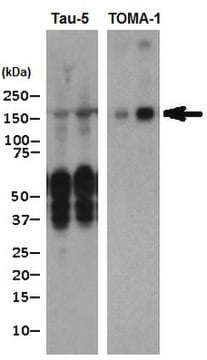추천 제품
생물학적 소스
rat
Quality Level
항체 형태
culture supernatant
항체 생산 유형
primary antibodies
클론
hPS1-NT, monoclonal
종 반응성
human
제조업체/상표
Chemicon®
기술
ELISA: suitable
immunohistochemistry: suitable
immunoprecipitation (IP): suitable
western blot: suitable
동형
IgG2a
NCBI 수납 번호
UniProt 수납 번호
배송 상태
wet ice
타겟 번역 후 변형
unmodified
유전자 정보
human ... PSEN1(5663)
특이성
Recognizes Presenilin-1, human. By Western blot the antibody recognizes a predominant 32 kDa polypeptide in a variety of samples, including PC12 cells transfected with human PS1 complementary DNA, brain biopsy specimens from demented patients, and postmortem samples of frontal neucortex from Familial Alzheimer′s Disease cases, late-onset Alzheimer′s disease cases, and cases of other degenerative disorders. Immunohistochemical studies of control brains revealed that PS1 is expressed primarily in neurons, with the protein localizing in the soma and dendritic processes. In contrast in FAD and sporadic Alzheimer′s disease cases, PS1 immunoreactivity was present in the neuritic component of senile plaques as well as in neurofibrillary tangles. Localization of PS1 immunoreactivity in familial and sporadic Alzheimer′s disease suggest that genetically heterogeneous forms of the disease share a common pathophysiology involving PS1 protein.
면역원
A fusion protein antigen containing the N-terminus of human PS-1 (residues 21-80) fused to GST.
Epitope: N-terminus
애플리케이션
Immunohistochemistry: rat pups and 24 old month rats were perfused for 10 minutes with 100-200mL of 4% PFA 0.3% glutaraldehyde and 0.1% CaCl2 in 0.1M PBS pH 7.4. Vibratome sections were blocked with 3% normal serum and permeabilized with 0.1% triton X-100.{Neuroscience 2003 120:405-423}.
Immunoblotting: 1:250-1:500. Recommend blocking buffer is TBS containing 5% non fat milk and 0.01% Tween 20. It is recommended that you also dilute the antibody in this blocking buffer. Incubate with the MAB1563 for 1 to 2 hours at room temperature or overnight at 4°C.
Immunoprecipitation
ELISA
Optimal working dilutions must be determined by end user.
Immunoblotting: 1:250-1:500. Recommend blocking buffer is TBS containing 5% non fat milk and 0.01% Tween 20. It is recommended that you also dilute the antibody in this blocking buffer. Incubate with the MAB1563 for 1 to 2 hours at room temperature or overnight at 4°C.
Immunoprecipitation
ELISA
Optimal working dilutions must be determined by end user.
Research Category
Neuroscience
Neuroscience
Research Sub Category
Neurodegenerative Diseases
Neurodegenerative Diseases
This Anti-Presenilin-1 Antibody, N-terminus, clone hPS1-NT is validated for use in ELISA, IH, IP, WB for the detection of Presenilin-1.
표적 설명
32 kDa
물리적 형태
UnPurified mouse tissue culture supernatant from a perfusion system, filtered through a 0.2μ micron membrane prior to vialing. Product contains 20%FBS and Ciprofloxacin at final concentration of 10μg/mL.
Unpurified
저장 및 안정성
Maintain for 1 year at -20°C from date of shipment. Aliquot to avoid repeated freezing and thawing. For maximum recovery of product, centrifuge the original vial after thawing and prior to removing the cap.
분석 메모
Control
Brain tissue
Brain tissue
기타 정보
Concentration: Please refer to the Certificate of Analysis for the lot-specific concentration.
법적 정보
CHEMICON is a registered trademark of Merck KGaA, Darmstadt, Germany
면책조항
Unless otherwise stated in our catalog or other company documentation accompanying the product(s), our products are intended for research use only and are not to be used for any other purpose, which includes but is not limited to, unauthorized commercial uses, in vitro diagnostic uses, ex vivo or in vivo therapeutic uses or any type of consumption or application to humans or animals.
적합한 제품을 찾을 수 없으신가요?
당사의 제품 선택기 도구.을(를) 시도해 보세요.
Storage Class Code
10 - Combustible liquids
WGK
WGK 1
Flash Point (°F)
Not applicable
Flash Point (°C)
Not applicable
시험 성적서(COA)
제품의 로트/배치 번호를 입력하여 시험 성적서(COA)을 검색하십시오. 로트 및 배치 번호는 제품 라벨에 있는 ‘로트’ 또는 ‘배치’라는 용어 뒤에서 찾을 수 있습니다.
Lindsay Poppe et al.
Alzheimer's research & therapy, 11(1), 102-102 (2019-12-14)
EphA4 is a receptor of the ephrin system regulating spine morphology and plasticity in the brain. These processes are pivotal in the pathophysiology of Alzheimer's disease (AD), characterized by synapse dysfunction and loss, and the progressive loss of memory and
Sun Young Oh et al.
Journal of neurochemistry, 113(1), 262-274 (2010-01-22)
The amyloid precursor protein is a ubiquitously expressed transmembrane protein that has been long implicated in the pathogenesis of Alzheimer's disease but its normal biological function has remained elusive despite extensive effort. We have previously reported the identification of Notch2
Nuomin Li et al.
Frontiers in aging neuroscience, 8, 51-51 (2016-03-26)
Alzheimer disease (AD) is characterized by progressive memory loss, reduction in cognitive functions, and damage to the brain. The β-amyloid precursor protein can be sequentially cleaved by β- secretase and γ-secretase. Mutations in the presenilin1(PS1) are the most common cause
Claudia Marinangeli et al.
The Journal of biological chemistry, 290(11), 7169-7184 (2015-01-24)
Understanding the molecular mechanisms controlling the physiological and pathological activity of γ-secretase represents a challenging task in Alzheimer disease research. The assembly and proteolytic activity of this enzyme require the correct interaction of the 19 transmembrane domains (TMDs) present in
Dieter Petit et al.
The EMBO journal, 38(12) (2019-05-22)
γ-Secretase complexes (GSECs) are multimeric membrane proteases involved in a variety of physiological processes and linked to Alzheimer's disease (AD). Presenilin (PSEN, catalytic subunit), Nicastrin (NCT), Presenilin Enhancer 2 (PEN-2), and Anterior Pharynx Defective 1 (APH1) are the essential subunits
자사의 과학자팀은 생명 과학, 재료 과학, 화학 합성, 크로마토그래피, 분석 및 기타 많은 영역을 포함한 모든 과학 분야에 경험이 있습니다..
고객지원팀으로 연락바랍니다.







